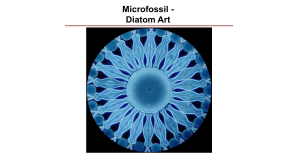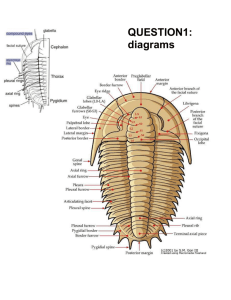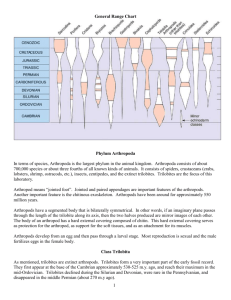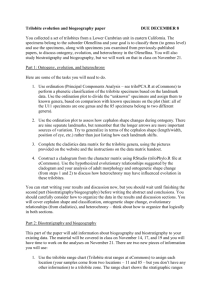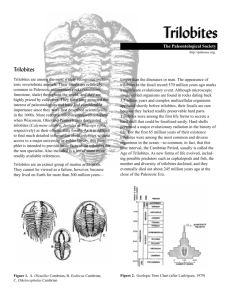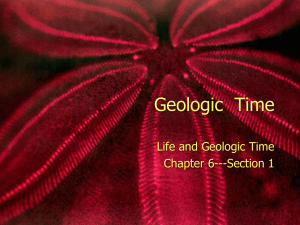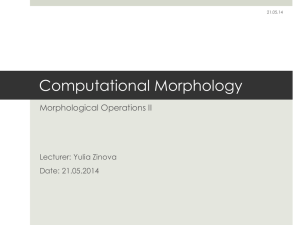Trilobites - Geology Rocks
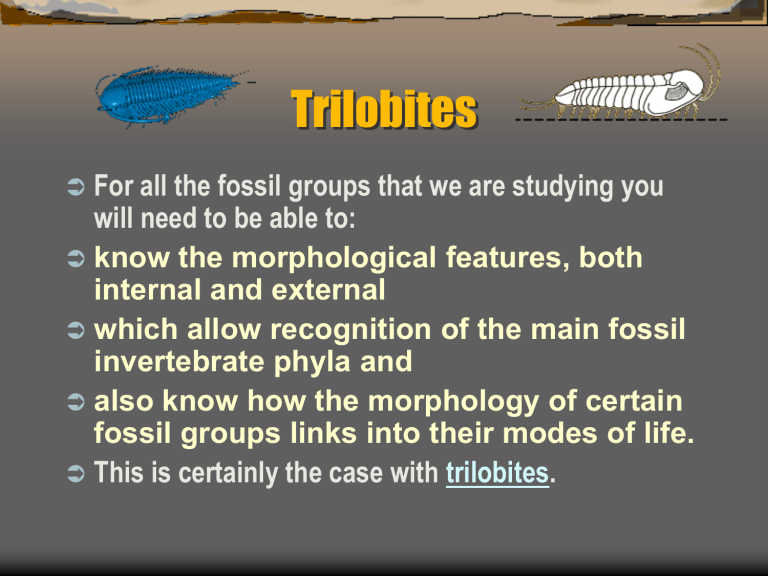
Trilobites
For all the fossil groups that we are studying you will need to be able to:
know the morphological features, both internal and external
which allow recognition of the main fossil invertebrate phyla and
also know how the morphology of certain fossil groups links into their modes of life.
This is certainly the case with trilobites .
Trilobites: Specification
In particular you need to know about:
5.4.2. Morphology :
Cephalon
Thorax
Pygidium
Glabella compound eyes facial suture
Spines shape of exoskeleton nature and position of legs, gills and mouth.
Trilobites: Specification 2
In addition to the morphology you also need to know about:
5.4.4. Palaeoenvironments and mode of life .
explain how trilobites show adaptive radiation to
Nektonic
Pelagic benthonic and infaunal modes of life.
Trilobites: Introduction
Look in your textbook
( Black ) and draw a diagram of a typical trilobite ( page 145 a, c and d ).
Label it fully including the features mentioned earlier.
Trilobites: introduction 2
Trilobites first evolved in the
Lower Cambrian and became extinct by the end of the
Permian .
They are most common during the Cambrian, Ordovician and
Silurian .
Therefore they have no modern equivalents and an understanding of their soft parts has to be based on modern day arthropods that show some similarity i.e. crustaceans.
They are marine animals.
This is a great site on trilobite morphology.
www.aloha.net/~smgon/ord ersoftrilobites.htm
They are segmented animals and have a chitinous exoskeleton.
They have a bilateral symmetry i.e. either side is symmetrical.
They have jointed limbs with an identical pair on the either side of the body.
The body can be divided into segments:
Laterally:
A central or axial segment.
Bounded by two lateral segments.
Transversely into three regions:
Cephalon “head” area.
Thorax “body” with hinged segments.
Pygidium “tail” with fused segments.
Trilobites tend to be fairly small being 5 - 8 cm long on average although extremes do occur from 5 mm to 70 cm.
Because they had a rigid exoskeleton growth caused problems.
How did they grow?
They malted i.e. they shed their exoskeletons for a larger by a process called “ ecdysis ”.
Ecdysis
The animation depicts a
Paradoxides trilobite molting
(right is the animal in top view).
In the animation, the facial sutures ( red ) split, opening the cephalon .
This provides an exit for the molting trilobite (purple ) from its old exoskeleton ( orange ).
Cephalon
This is the head shield, which consists of a central region
GLABELLA, or axial region.
The glabella is usually convex but does vary in size and shape in different species.
The FACIAL SUTURE is the line along which the skeleton is cracked to allow ecdysis , it divides the cheeks into 2 areas:
FIXED CHEEK: That part which stays attached to the glabella.
FREE CHEEK: That part which becomes separated during ecdysis.
The three main types of facial sutures are defined by where the suture ends, relative to the genal angle:
All images this page except where noted ©1999 - 2002 by
S. M. Gon III.
Created using Macromedia Freehand 8.0
Here are some examples of the three suture types:
Eodiscina
(proparian)
Phacopina
(proparian)
Calymenina
(gonatoparian)
Ptychopariina
(opisthoparian)
Asaphida
(opisthoparian)
Trilobites developed one of the first advanced visual systems in the animal kingdom.
The majority of trilobites bore a pair of compound eyes (made up of many lensed units).
Compound eyes in living arthropods such as insects are very sensitive to motion , and probably allowed predator detection in trilobites.
They typically occupied the outer edges of the cephalon (free cheeks) on either side of the glabella, adjacent to the facial sutures.
Trilobite Eyes
Trilobite Eyes
At least one suborder of trilobites, the Agnostids
( Agnostus ), are thought to be primarily eyeless.
In contrast, a few secondarily eyeless species (in which a clear evolutionary trend toward reduced eye size with eventual disappearance of eyes altogether) have developed within several groups, even those known for large, well-developed eyes.
Some trilobites have spines, which extend backwards, from the cephalon: GENAL
SPINES .
Glabella end = ANTERIOR
Pygidium end = POSTERIOR
See page 152 Black a, b, f, g for examples.
Top side of the cephalon =
DORSAL .
Bottom of cephalon =
VENTRAL.
On the ventral side are some small plates, one the
HYPOSTOME protects the mouth. See page 150 Black .
Trilobites can be divided into three from side to side.
It has a central axis separated from the 2 lateral regions by the
AXIAL FURROW .
Each segment of the lateral area has PLEURA .
The thorax contains segments, which are jointed and able to move independently.
This flexibility allows some trilobites to roll up to give protection to the softer under part.
The number of these segments varies e.g. 2 - 40 .
However, in any Genera the number is constant e.g.
13 in Calymene .
Underneath each pleura is a jointed limb and a gill .
Look at page 145 .
These are in pairs one on each side of the body
.
This is a semicircular or triangular shield.
These have a number of fused segments , which varies from 2 - 30 but cannot move independently.
the pygidium (tail piece) can range from extremely small
(much smaller than the cephalon) to larger than the cephalon. There are four general categories of pygidium relative size, shown below: micropygous pygidium much smaller than cephalon subisopygous pygidium subequal to cephalon isopygous pygidium equal to cephalon macropygous pygidium larger than cephalon
We will study 7 trilobites in more detail and see how their morphology relates to their mode of life .
Clearly this is important to study because it may turn up in the exam and also it is a classic extended prose question.
The trilobites to be studied include:
Calymene
Dalmanites
Deiphon
Trinucleus
Agnostus
Paradoxides
Encrinurus
Biological Definitions
Plankton (Planktonic) - organisms that float suspended in the water column and have insufficient swimming ability to avoid transport by ocean currents
Nekton (Nektonic) - strongly swimming organisms such as fish, mammals, and squid
Both planktonic and nektonic live within the water column and so are PELAGIC .
Benthos (Benthonic) - organisms that live in intimate contact with the ocean floor
Benthonic: can be further subdivided:
Live on the surface = EPIFUANAL .
Live under the surface INFAUNAL like burrowers
Those things that do not move
= SEDENTARY .
Those things that do move are called VAGRANT .
Trilobite Modes of Life
Most trilobites are benthonic and crawl around on the seabed.
Sometimes they spread their weight by using spines or some plough through the soft sediment.
Some even bury themselves.
A few trilobites are pelagic and were streamlined enough to be able to swim close to the sea floor.
They usually lived on the continental shelf where there is abundant life = shallow enough to have some light to stimulate the food chain.
As mentioned earlier you will study 7 trilobites in more detail and see how their morphology relates to their mode of life .
The trilobites to be studied are:
Calymene
Dalmanites
Deiphon
Trinucleus
Agnostus
Paradoxides
Encrinurus
What to do?
For each trilobite you must do the following:
Draw a diagram of it.
Label any relevant features.
Note down its mode of life.
Note down the adaptations it made towards this mode of life.
